Lilliput's Financial Resources and Decisions: A Detailed Report
VerifiedAdded on 2020/07/23
|22
|4862
|28
Report
AI Summary
This report provides a detailed analysis of financial resource management and decision-making for Lilliput, a small sector enterprise. The report explores various sources of finance, including bank loans, selling assets, personal resources, and venture capitalists, along with their implications. It examines the costs associated with each source and the importance of financial planning, including the information needed for internal and external decision-makers. The report also delves into financial statement analysis, covering important financial statements and ratio analysis to assess the financial health of the company. Furthermore, the report investigates the link between cost and selling price, and the assessment of project viability, providing a comprehensive overview of financial management practices within the context of a small business.
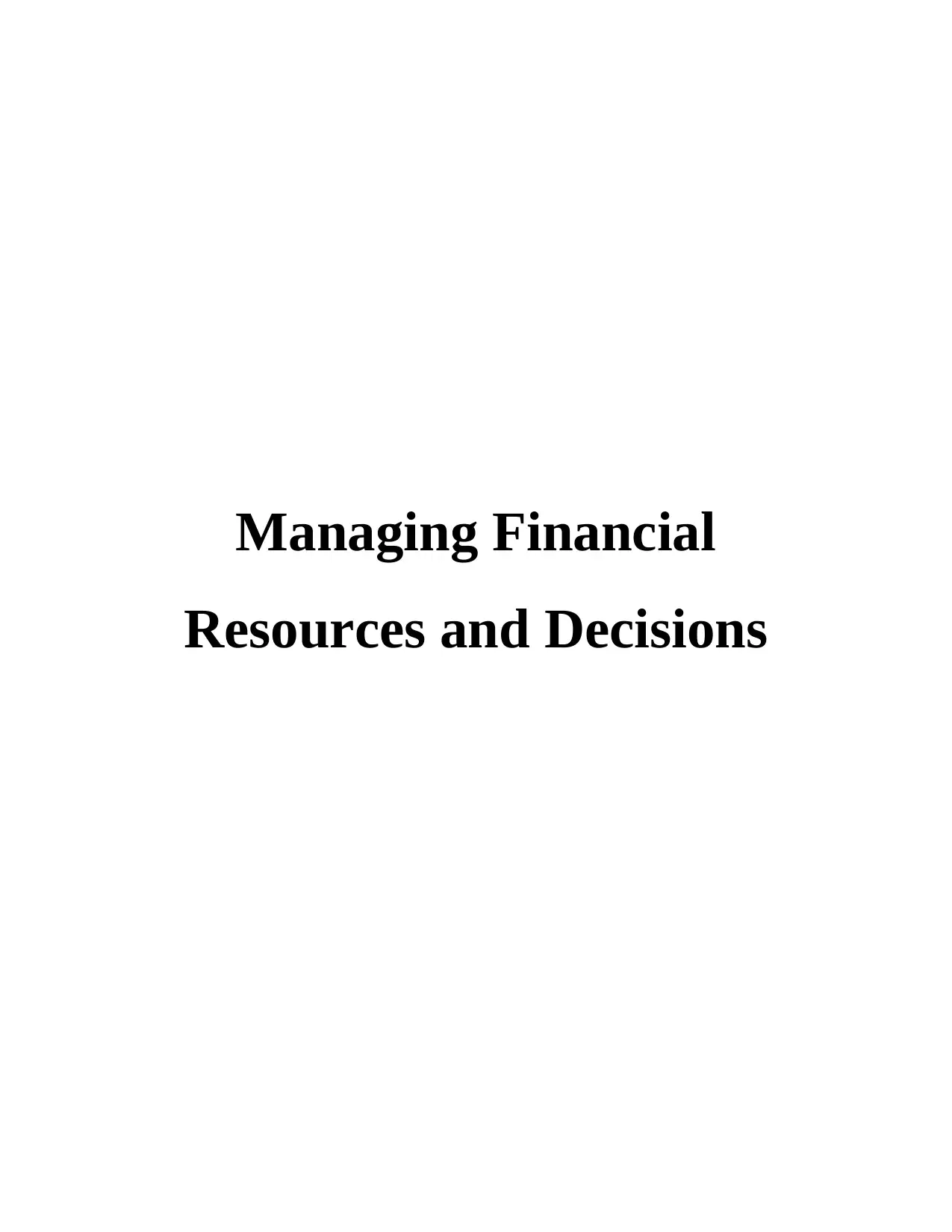
Managing Financial
Resources and Decisions
Resources and Decisions
Paraphrase This Document
Need a fresh take? Get an instant paraphrase of this document with our AI Paraphraser
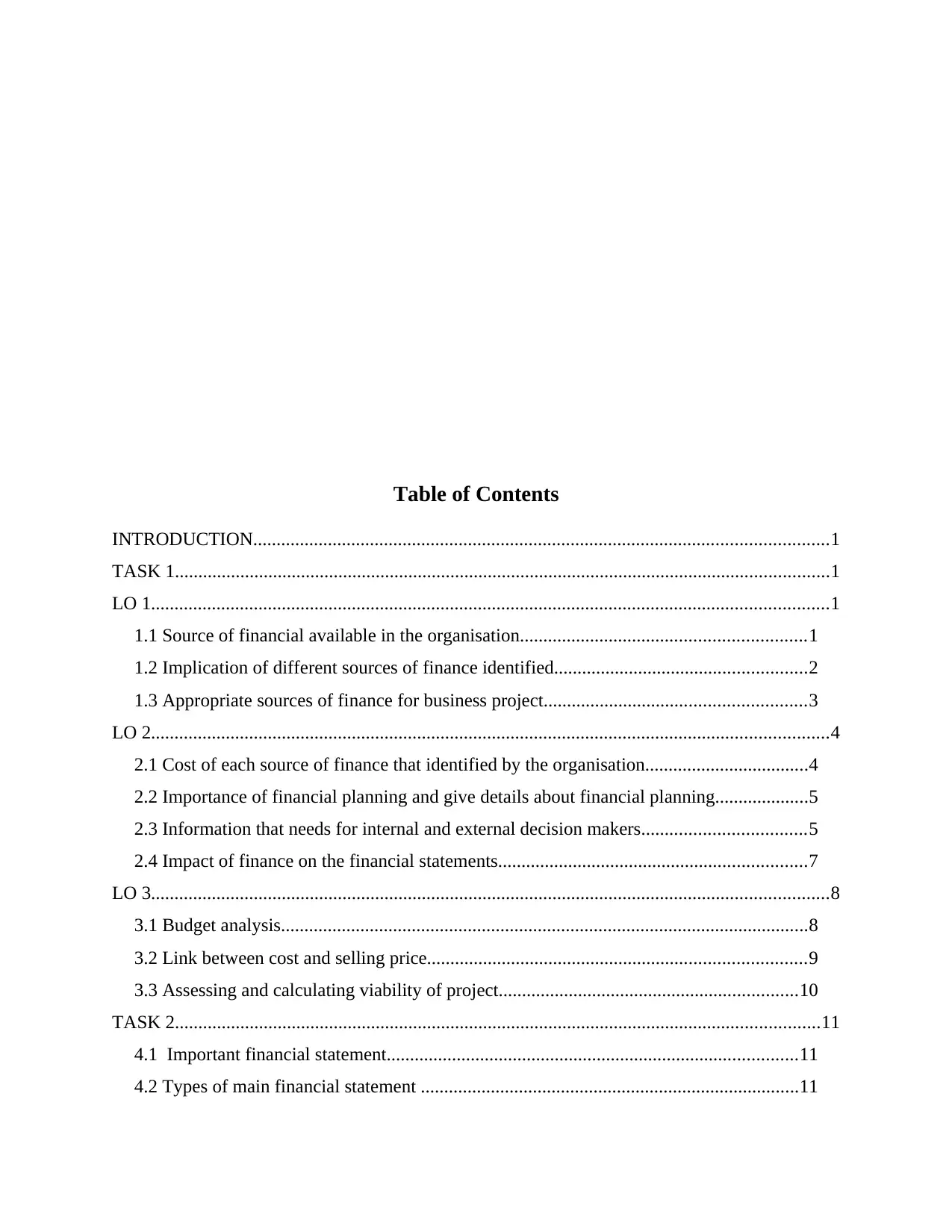
Table of Contents
INTRODUCTION...........................................................................................................................1
TASK 1............................................................................................................................................1
LO 1.................................................................................................................................................1
1.1 Source of financial available in the organisation.............................................................1
1.2 Implication of different sources of finance identified......................................................2
1.3 Appropriate sources of finance for business project........................................................3
LO 2.................................................................................................................................................4
2.1 Cost of each source of finance that identified by the organisation...................................4
2.2 Importance of financial planning and give details about financial planning....................5
2.3 Information that needs for internal and external decision makers...................................5
2.4 Impact of finance on the financial statements..................................................................7
LO 3.................................................................................................................................................8
3.1 Budget analysis.................................................................................................................8
3.2 Link between cost and selling price.................................................................................9
3.3 Assessing and calculating viability of project................................................................10
TASK 2..........................................................................................................................................11
4.1 Important financial statement........................................................................................11
4.2 Types of main financial statement .................................................................................11
INTRODUCTION...........................................................................................................................1
TASK 1............................................................................................................................................1
LO 1.................................................................................................................................................1
1.1 Source of financial available in the organisation.............................................................1
1.2 Implication of different sources of finance identified......................................................2
1.3 Appropriate sources of finance for business project........................................................3
LO 2.................................................................................................................................................4
2.1 Cost of each source of finance that identified by the organisation...................................4
2.2 Importance of financial planning and give details about financial planning....................5
2.3 Information that needs for internal and external decision makers...................................5
2.4 Impact of finance on the financial statements..................................................................7
LO 3.................................................................................................................................................8
3.1 Budget analysis.................................................................................................................8
3.2 Link between cost and selling price.................................................................................9
3.3 Assessing and calculating viability of project................................................................10
TASK 2..........................................................................................................................................11
4.1 Important financial statement........................................................................................11
4.2 Types of main financial statement .................................................................................11
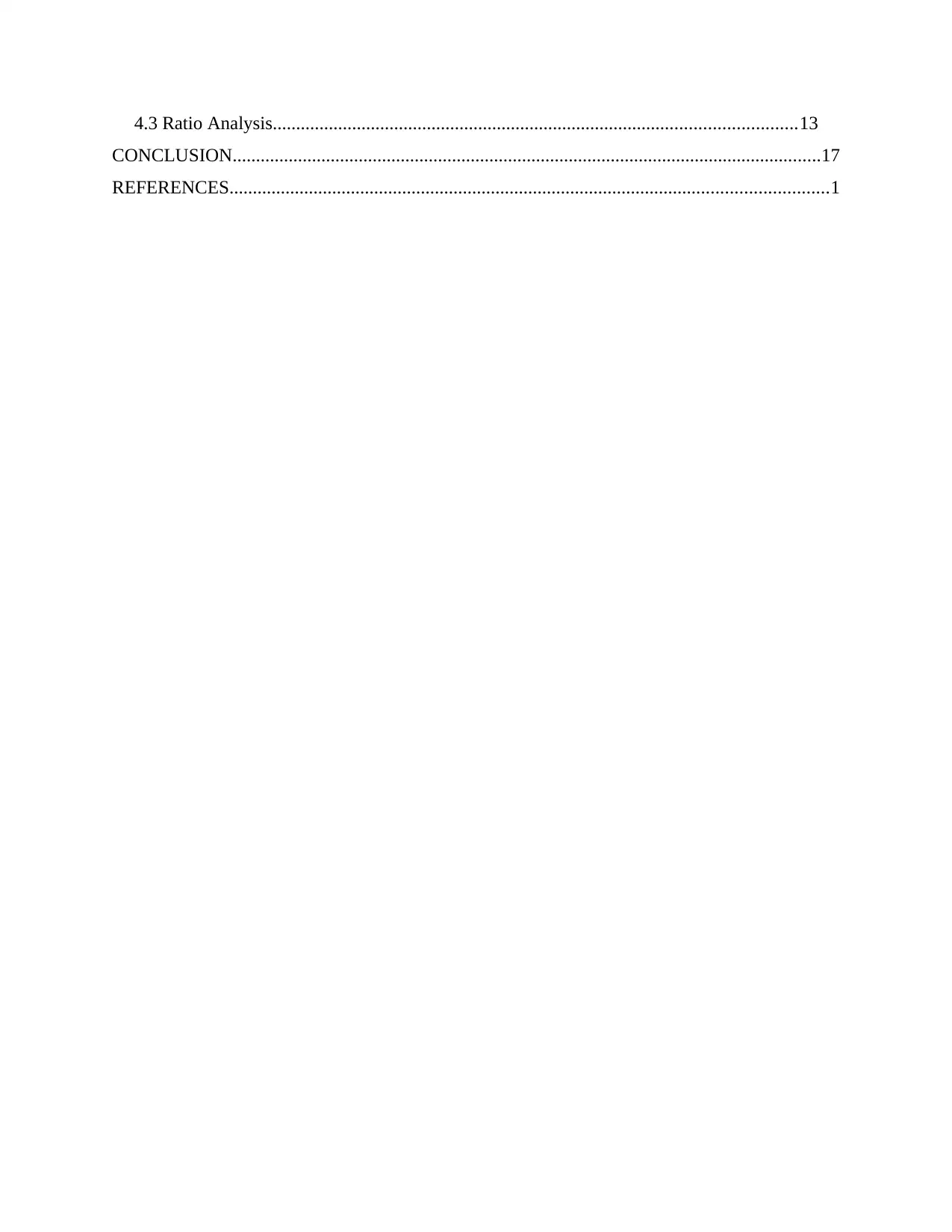
4.3 Ratio Analysis................................................................................................................13
CONCLUSION..............................................................................................................................17
REFERENCES................................................................................................................................1
CONCLUSION..............................................................................................................................17
REFERENCES................................................................................................................................1
⊘ This is a preview!⊘
Do you want full access?
Subscribe today to unlock all pages.

Trusted by 1+ million students worldwide
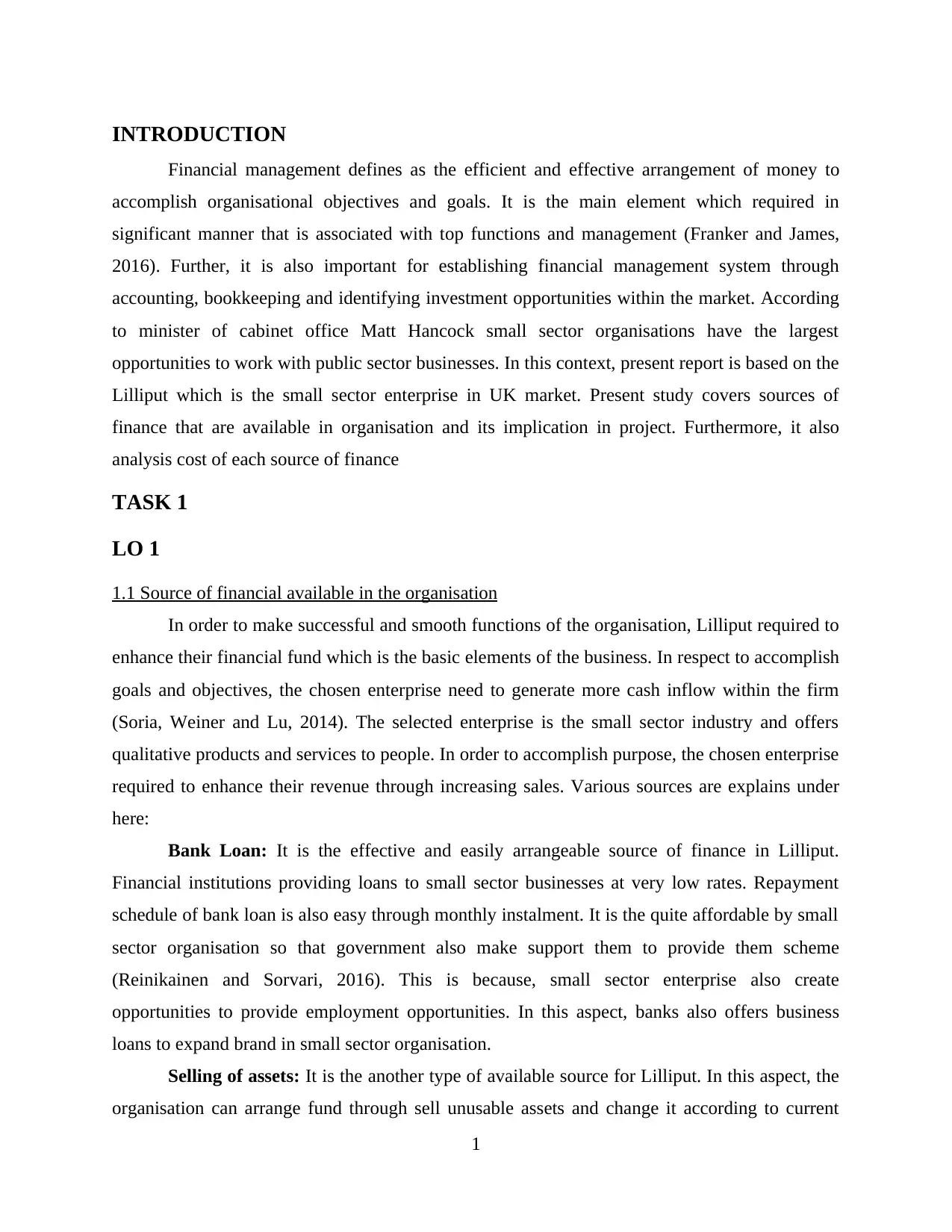
INTRODUCTION
Financial management defines as the efficient and effective arrangement of money to
accomplish organisational objectives and goals. It is the main element which required in
significant manner that is associated with top functions and management (Franker and James,
2016). Further, it is also important for establishing financial management system through
accounting, bookkeeping and identifying investment opportunities within the market. According
to minister of cabinet office Matt Hancock small sector organisations have the largest
opportunities to work with public sector businesses. In this context, present report is based on the
Lilliput which is the small sector enterprise in UK market. Present study covers sources of
finance that are available in organisation and its implication in project. Furthermore, it also
analysis cost of each source of finance
TASK 1
LO 1
1.1 Source of financial available in the organisation
In order to make successful and smooth functions of the organisation, Lilliput required to
enhance their financial fund which is the basic elements of the business. In respect to accomplish
goals and objectives, the chosen enterprise need to generate more cash inflow within the firm
(Soria, Weiner and Lu, 2014). The selected enterprise is the small sector industry and offers
qualitative products and services to people. In order to accomplish purpose, the chosen enterprise
required to enhance their revenue through increasing sales. Various sources are explains under
here:
Bank Loan: It is the effective and easily arrangeable source of finance in Lilliput.
Financial institutions providing loans to small sector businesses at very low rates. Repayment
schedule of bank loan is also easy through monthly instalment. It is the quite affordable by small
sector organisation so that government also make support them to provide them scheme
(Reinikainen and Sorvari, 2016). This is because, small sector enterprise also create
opportunities to provide employment opportunities. In this aspect, banks also offers business
loans to expand brand in small sector organisation.
Selling of assets: It is the another type of available source for Lilliput. In this aspect, the
organisation can arrange fund through sell unusable assets and change it according to current
1
Financial management defines as the efficient and effective arrangement of money to
accomplish organisational objectives and goals. It is the main element which required in
significant manner that is associated with top functions and management (Franker and James,
2016). Further, it is also important for establishing financial management system through
accounting, bookkeeping and identifying investment opportunities within the market. According
to minister of cabinet office Matt Hancock small sector organisations have the largest
opportunities to work with public sector businesses. In this context, present report is based on the
Lilliput which is the small sector enterprise in UK market. Present study covers sources of
finance that are available in organisation and its implication in project. Furthermore, it also
analysis cost of each source of finance
TASK 1
LO 1
1.1 Source of financial available in the organisation
In order to make successful and smooth functions of the organisation, Lilliput required to
enhance their financial fund which is the basic elements of the business. In respect to accomplish
goals and objectives, the chosen enterprise need to generate more cash inflow within the firm
(Soria, Weiner and Lu, 2014). The selected enterprise is the small sector industry and offers
qualitative products and services to people. In order to accomplish purpose, the chosen enterprise
required to enhance their revenue through increasing sales. Various sources are explains under
here:
Bank Loan: It is the effective and easily arrangeable source of finance in Lilliput.
Financial institutions providing loans to small sector businesses at very low rates. Repayment
schedule of bank loan is also easy through monthly instalment. It is the quite affordable by small
sector organisation so that government also make support them to provide them scheme
(Reinikainen and Sorvari, 2016). This is because, small sector enterprise also create
opportunities to provide employment opportunities. In this aspect, banks also offers business
loans to expand brand in small sector organisation.
Selling of assets: It is the another type of available source for Lilliput. In this aspect, the
organisation can arrange fund through sell unusable assets and change it according to current
1
Paraphrase This Document
Need a fresh take? Get an instant paraphrase of this document with our AI Paraphraser

trends. This is because, it assists to meet with needs of the company that required to offers
different types of products and services that are possessed high demand (Giordano and Shah,
2014). Further, it also sale dead goods at low rates to collect amount for other expansion. Beside
this, the chosen enterprise can also sale old machinery to getting fund for expansion of the
organisation.
Personal resources: It also other source of finance in which Lilliput can use their own
fund within the enterprise. As compare to this, in this aspect risk also take place which harm to
financial position of owner (Haddow, Bullock and Coppola, 2017).
Venture capitalists: It is the best way to arrange source of finance within the
organisation. In this aspect, Lilliput can convince to investors to invest amount in the firm.
Hence, the organisation has opportunity to make effective functions and operations to increase
operations.
1.2 Implication of different sources of finance identified
In order to make implications, different sources can be determines in the following
aspects:
Source Implication in term
of economic
Implication in term
of legal
Implication in term
of ownership
Bank loan The selected enterprise
need to demonstrates
security to borrow
Legal agreement also
required in the
selected business and
Ownership always
remain same and it is
not diluted.
2
Illustration 1: Source of finance
different types of products and services that are possessed high demand (Giordano and Shah,
2014). Further, it also sale dead goods at low rates to collect amount for other expansion. Beside
this, the chosen enterprise can also sale old machinery to getting fund for expansion of the
organisation.
Personal resources: It also other source of finance in which Lilliput can use their own
fund within the enterprise. As compare to this, in this aspect risk also take place which harm to
financial position of owner (Haddow, Bullock and Coppola, 2017).
Venture capitalists: It is the best way to arrange source of finance within the
organisation. In this aspect, Lilliput can convince to investors to invest amount in the firm.
Hence, the organisation has opportunity to make effective functions and operations to increase
operations.
1.2 Implication of different sources of finance identified
In order to make implications, different sources can be determines in the following
aspects:
Source Implication in term
of economic
Implication in term
of legal
Implication in term
of ownership
Bank loan The selected enterprise
need to demonstrates
security to borrow
Legal agreement also
required in the
selected business and
Ownership always
remain same and it is
not diluted.
2
Illustration 1: Source of finance
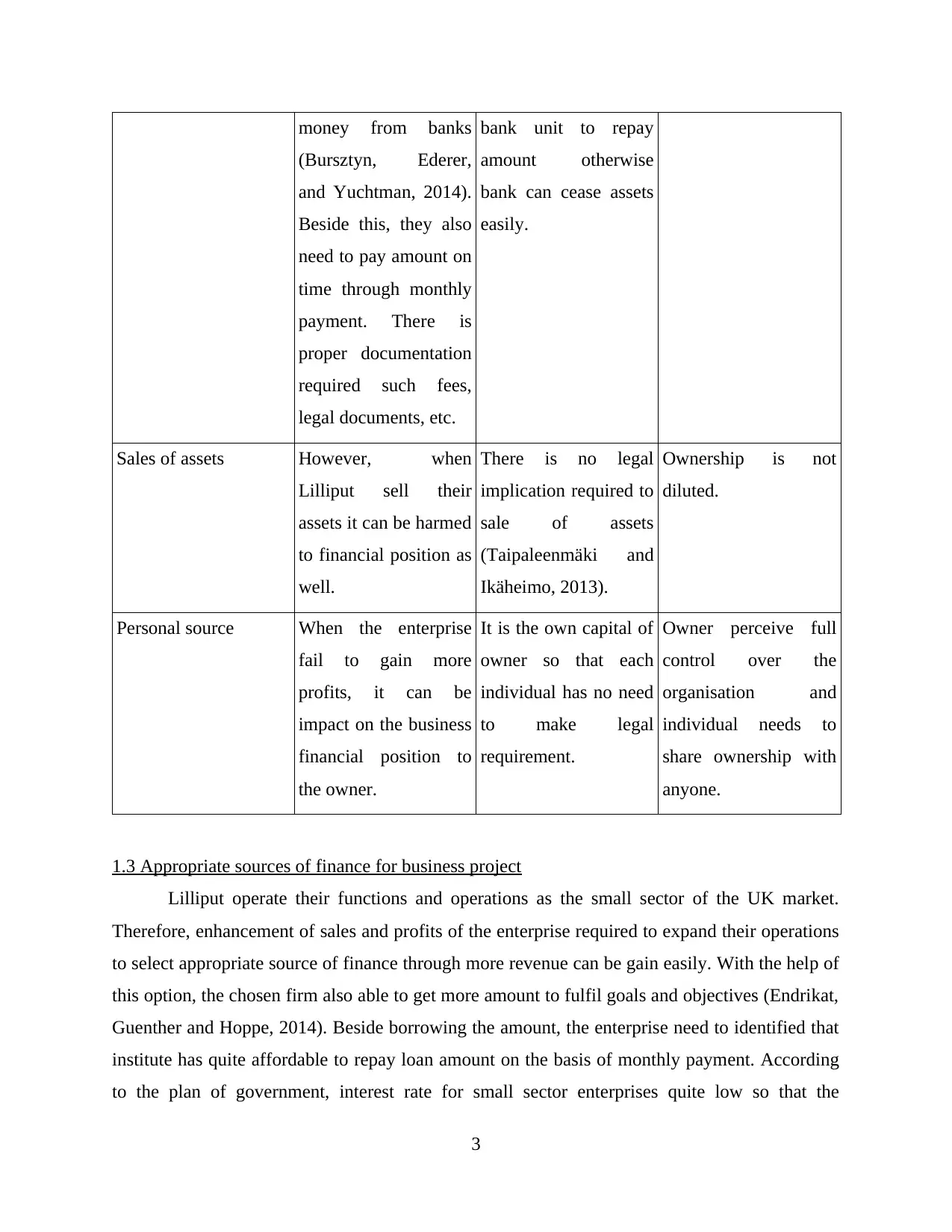
money from banks
(Bursztyn, Ederer,
and Yuchtman, 2014).
Beside this, they also
need to pay amount on
time through monthly
payment. There is
proper documentation
required such fees,
legal documents, etc.
bank unit to repay
amount otherwise
bank can cease assets
easily.
Sales of assets However, when
Lilliput sell their
assets it can be harmed
to financial position as
well.
There is no legal
implication required to
sale of assets
(Taipaleenmäki and
Ikäheimo, 2013).
Ownership is not
diluted.
Personal source When the enterprise
fail to gain more
profits, it can be
impact on the business
financial position to
the owner.
It is the own capital of
owner so that each
individual has no need
to make legal
requirement.
Owner perceive full
control over the
organisation and
individual needs to
share ownership with
anyone.
1.3 Appropriate sources of finance for business project
Lilliput operate their functions and operations as the small sector of the UK market.
Therefore, enhancement of sales and profits of the enterprise required to expand their operations
to select appropriate source of finance through more revenue can be gain easily. With the help of
this option, the chosen firm also able to get more amount to fulfil goals and objectives (Endrikat,
Guenther and Hoppe, 2014). Beside borrowing the amount, the enterprise need to identified that
institute has quite affordable to repay loan amount on the basis of monthly payment. According
to the plan of government, interest rate for small sector enterprises quite low so that the
3
(Bursztyn, Ederer,
and Yuchtman, 2014).
Beside this, they also
need to pay amount on
time through monthly
payment. There is
proper documentation
required such fees,
legal documents, etc.
bank unit to repay
amount otherwise
bank can cease assets
easily.
Sales of assets However, when
Lilliput sell their
assets it can be harmed
to financial position as
well.
There is no legal
implication required to
sale of assets
(Taipaleenmäki and
Ikäheimo, 2013).
Ownership is not
diluted.
Personal source When the enterprise
fail to gain more
profits, it can be
impact on the business
financial position to
the owner.
It is the own capital of
owner so that each
individual has no need
to make legal
requirement.
Owner perceive full
control over the
organisation and
individual needs to
share ownership with
anyone.
1.3 Appropriate sources of finance for business project
Lilliput operate their functions and operations as the small sector of the UK market.
Therefore, enhancement of sales and profits of the enterprise required to expand their operations
to select appropriate source of finance through more revenue can be gain easily. With the help of
this option, the chosen firm also able to get more amount to fulfil goals and objectives (Endrikat,
Guenther and Hoppe, 2014). Beside borrowing the amount, the enterprise need to identified that
institute has quite affordable to repay loan amount on the basis of monthly payment. According
to the plan of government, interest rate for small sector enterprises quite low so that the
3
⊘ This is a preview!⊘
Do you want full access?
Subscribe today to unlock all pages.

Trusted by 1+ million students worldwide
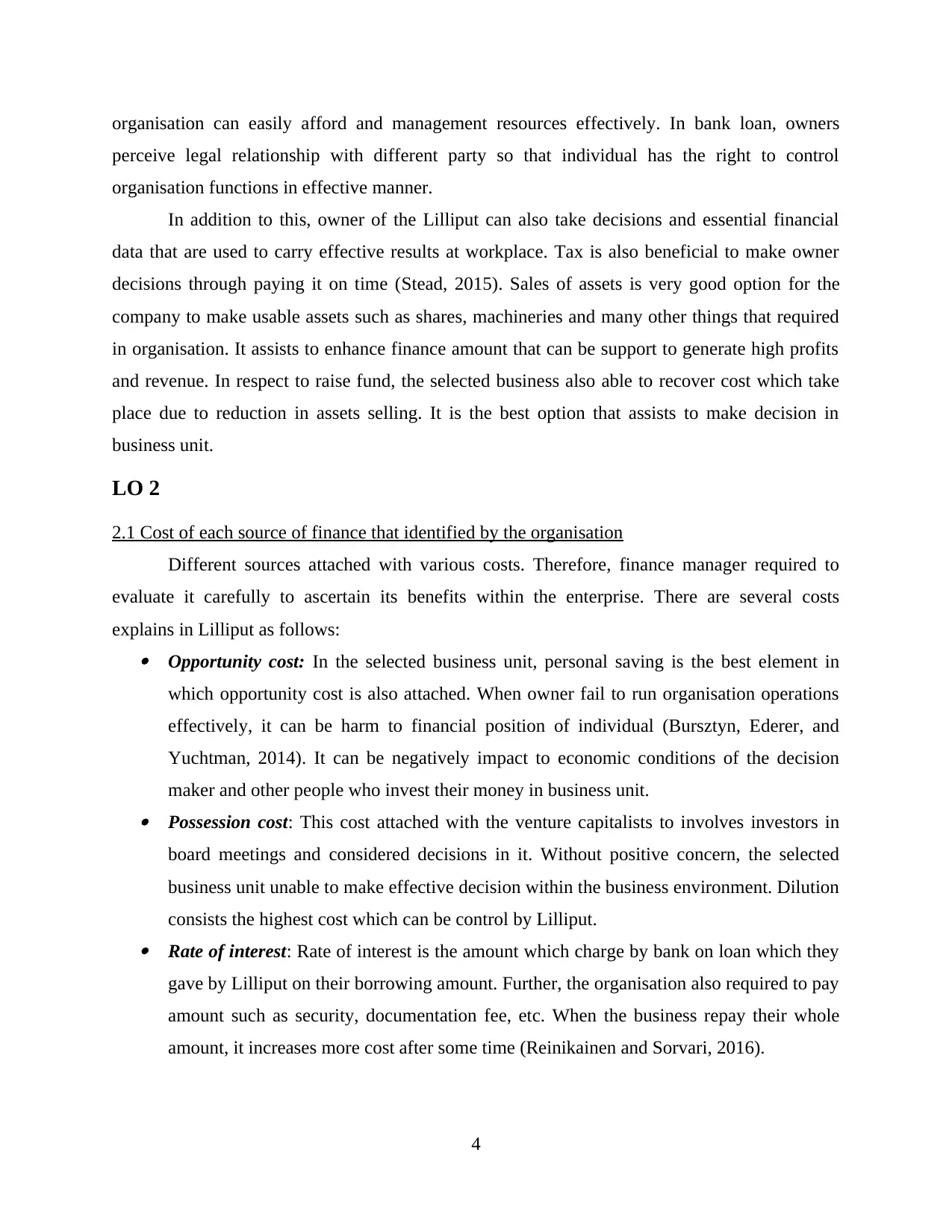
organisation can easily afford and management resources effectively. In bank loan, owners
perceive legal relationship with different party so that individual has the right to control
organisation functions in effective manner.
In addition to this, owner of the Lilliput can also take decisions and essential financial
data that are used to carry effective results at workplace. Tax is also beneficial to make owner
decisions through paying it on time (Stead, 2015). Sales of assets is very good option for the
company to make usable assets such as shares, machineries and many other things that required
in organisation. It assists to enhance finance amount that can be support to generate high profits
and revenue. In respect to raise fund, the selected business also able to recover cost which take
place due to reduction in assets selling. It is the best option that assists to make decision in
business unit.
LO 2
2.1 Cost of each source of finance that identified by the organisation
Different sources attached with various costs. Therefore, finance manager required to
evaluate it carefully to ascertain its benefits within the enterprise. There are several costs
explains in Lilliput as follows: Opportunity cost: In the selected business unit, personal saving is the best element in
which opportunity cost is also attached. When owner fail to run organisation operations
effectively, it can be harm to financial position of individual (Bursztyn, Ederer, and
Yuchtman, 2014). It can be negatively impact to economic conditions of the decision
maker and other people who invest their money in business unit. Possession cost: This cost attached with the venture capitalists to involves investors in
board meetings and considered decisions in it. Without positive concern, the selected
business unit unable to make effective decision within the business environment. Dilution
consists the highest cost which can be control by Lilliput. Rate of interest: Rate of interest is the amount which charge by bank on loan which they
gave by Lilliput on their borrowing amount. Further, the organisation also required to pay
amount such as security, documentation fee, etc. When the business repay their whole
amount, it increases more cost after some time (Reinikainen and Sorvari, 2016).
4
perceive legal relationship with different party so that individual has the right to control
organisation functions in effective manner.
In addition to this, owner of the Lilliput can also take decisions and essential financial
data that are used to carry effective results at workplace. Tax is also beneficial to make owner
decisions through paying it on time (Stead, 2015). Sales of assets is very good option for the
company to make usable assets such as shares, machineries and many other things that required
in organisation. It assists to enhance finance amount that can be support to generate high profits
and revenue. In respect to raise fund, the selected business also able to recover cost which take
place due to reduction in assets selling. It is the best option that assists to make decision in
business unit.
LO 2
2.1 Cost of each source of finance that identified by the organisation
Different sources attached with various costs. Therefore, finance manager required to
evaluate it carefully to ascertain its benefits within the enterprise. There are several costs
explains in Lilliput as follows: Opportunity cost: In the selected business unit, personal saving is the best element in
which opportunity cost is also attached. When owner fail to run organisation operations
effectively, it can be harm to financial position of individual (Bursztyn, Ederer, and
Yuchtman, 2014). It can be negatively impact to economic conditions of the decision
maker and other people who invest their money in business unit. Possession cost: This cost attached with the venture capitalists to involves investors in
board meetings and considered decisions in it. Without positive concern, the selected
business unit unable to make effective decision within the business environment. Dilution
consists the highest cost which can be control by Lilliput. Rate of interest: Rate of interest is the amount which charge by bank on loan which they
gave by Lilliput on their borrowing amount. Further, the organisation also required to pay
amount such as security, documentation fee, etc. When the business repay their whole
amount, it increases more cost after some time (Reinikainen and Sorvari, 2016).
4
Paraphrase This Document
Need a fresh take? Get an instant paraphrase of this document with our AI Paraphraser
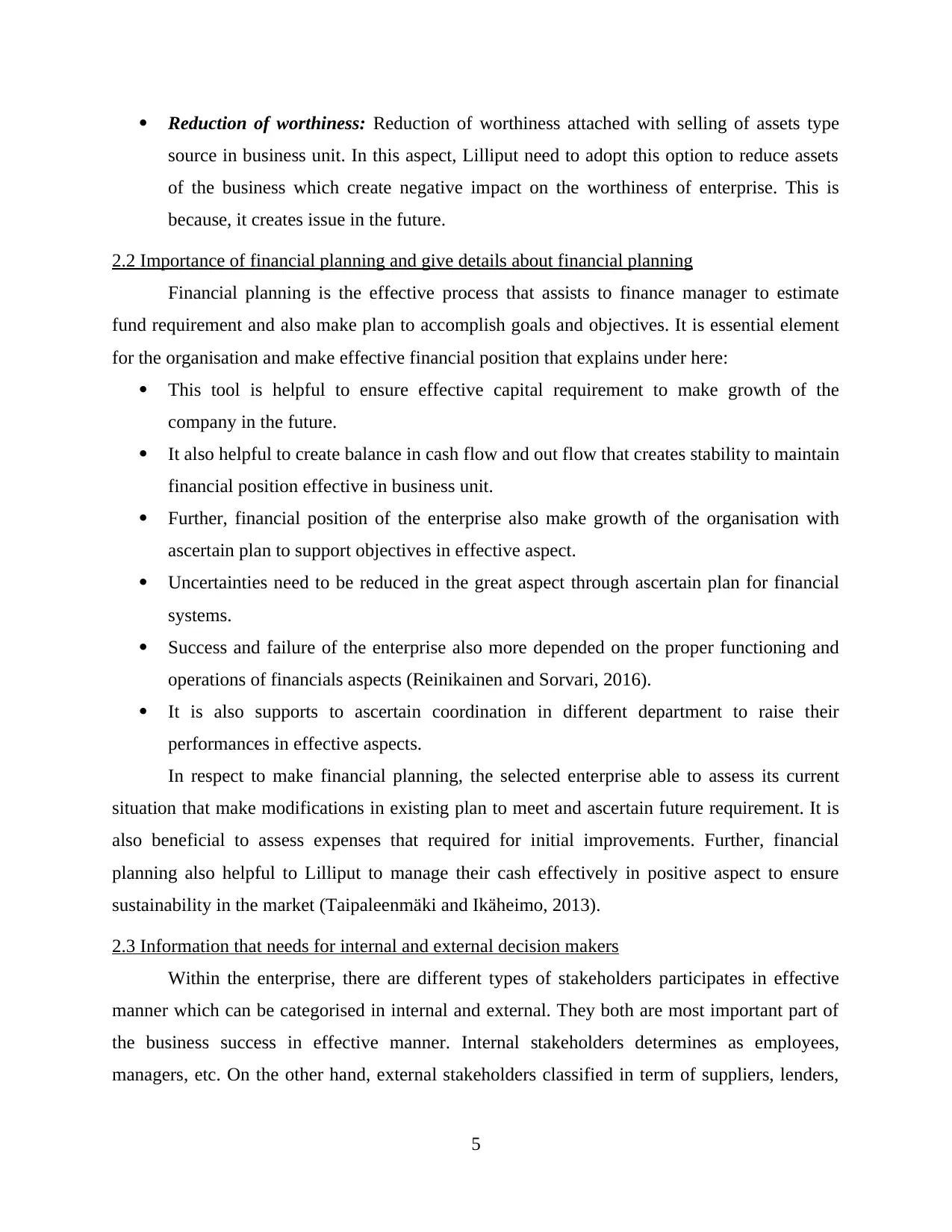
Reduction of worthiness: Reduction of worthiness attached with selling of assets type
source in business unit. In this aspect, Lilliput need to adopt this option to reduce assets
of the business which create negative impact on the worthiness of enterprise. This is
because, it creates issue in the future.
2.2 Importance of financial planning and give details about financial planning
Financial planning is the effective process that assists to finance manager to estimate
fund requirement and also make plan to accomplish goals and objectives. It is essential element
for the organisation and make effective financial position that explains under here:
This tool is helpful to ensure effective capital requirement to make growth of the
company in the future.
It also helpful to create balance in cash flow and out flow that creates stability to maintain
financial position effective in business unit.
Further, financial position of the enterprise also make growth of the organisation with
ascertain plan to support objectives in effective aspect.
Uncertainties need to be reduced in the great aspect through ascertain plan for financial
systems.
Success and failure of the enterprise also more depended on the proper functioning and
operations of financials aspects (Reinikainen and Sorvari, 2016).
It is also supports to ascertain coordination in different department to raise their
performances in effective aspects.
In respect to make financial planning, the selected enterprise able to assess its current
situation that make modifications in existing plan to meet and ascertain future requirement. It is
also beneficial to assess expenses that required for initial improvements. Further, financial
planning also helpful to Lilliput to manage their cash effectively in positive aspect to ensure
sustainability in the market (Taipaleenmäki and Ikäheimo, 2013).
2.3 Information that needs for internal and external decision makers
Within the enterprise, there are different types of stakeholders participates in effective
manner which can be categorised in internal and external. They both are most important part of
the business success in effective manner. Internal stakeholders determines as employees,
managers, etc. On the other hand, external stakeholders classified in term of suppliers, lenders,
5
source in business unit. In this aspect, Lilliput need to adopt this option to reduce assets
of the business which create negative impact on the worthiness of enterprise. This is
because, it creates issue in the future.
2.2 Importance of financial planning and give details about financial planning
Financial planning is the effective process that assists to finance manager to estimate
fund requirement and also make plan to accomplish goals and objectives. It is essential element
for the organisation and make effective financial position that explains under here:
This tool is helpful to ensure effective capital requirement to make growth of the
company in the future.
It also helpful to create balance in cash flow and out flow that creates stability to maintain
financial position effective in business unit.
Further, financial position of the enterprise also make growth of the organisation with
ascertain plan to support objectives in effective aspect.
Uncertainties need to be reduced in the great aspect through ascertain plan for financial
systems.
Success and failure of the enterprise also more depended on the proper functioning and
operations of financials aspects (Reinikainen and Sorvari, 2016).
It is also supports to ascertain coordination in different department to raise their
performances in effective aspects.
In respect to make financial planning, the selected enterprise able to assess its current
situation that make modifications in existing plan to meet and ascertain future requirement. It is
also beneficial to assess expenses that required for initial improvements. Further, financial
planning also helpful to Lilliput to manage their cash effectively in positive aspect to ensure
sustainability in the market (Taipaleenmäki and Ikäheimo, 2013).
2.3 Information that needs for internal and external decision makers
Within the enterprise, there are different types of stakeholders participates in effective
manner which can be categorised in internal and external. They both are most important part of
the business success in effective manner. Internal stakeholders determines as employees,
managers, etc. On the other hand, external stakeholders classified in term of suppliers, lenders,
5
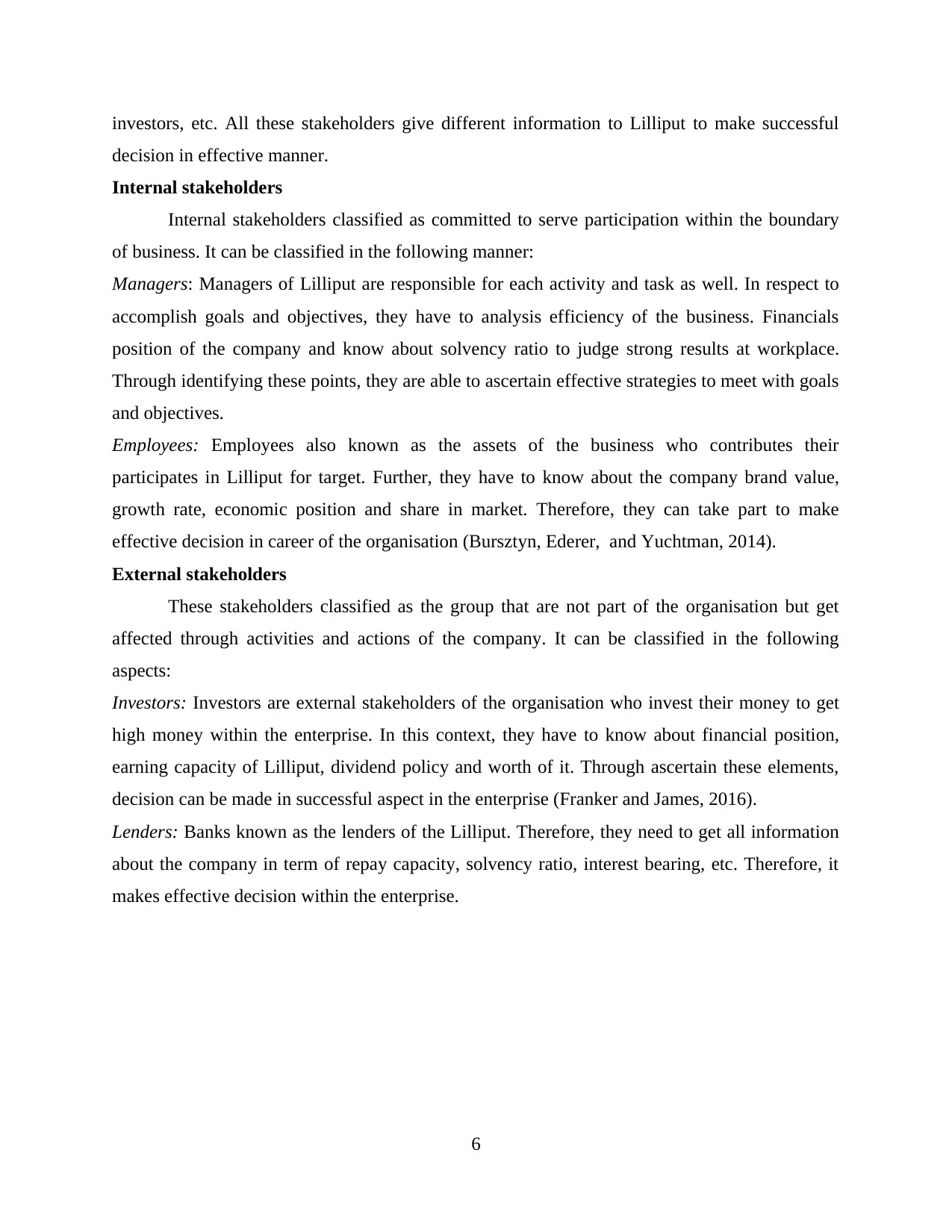
investors, etc. All these stakeholders give different information to Lilliput to make successful
decision in effective manner.
Internal stakeholders
Internal stakeholders classified as committed to serve participation within the boundary
of business. It can be classified in the following manner:
Managers: Managers of Lilliput are responsible for each activity and task as well. In respect to
accomplish goals and objectives, they have to analysis efficiency of the business. Financials
position of the company and know about solvency ratio to judge strong results at workplace.
Through identifying these points, they are able to ascertain effective strategies to meet with goals
and objectives.
Employees: Employees also known as the assets of the business who contributes their
participates in Lilliput for target. Further, they have to know about the company brand value,
growth rate, economic position and share in market. Therefore, they can take part to make
effective decision in career of the organisation (Bursztyn, Ederer, and Yuchtman, 2014).
External stakeholders
These stakeholders classified as the group that are not part of the organisation but get
affected through activities and actions of the company. It can be classified in the following
aspects:
Investors: Investors are external stakeholders of the organisation who invest their money to get
high money within the enterprise. In this context, they have to know about financial position,
earning capacity of Lilliput, dividend policy and worth of it. Through ascertain these elements,
decision can be made in successful aspect in the enterprise (Franker and James, 2016).
Lenders: Banks known as the lenders of the Lilliput. Therefore, they need to get all information
about the company in term of repay capacity, solvency ratio, interest bearing, etc. Therefore, it
makes effective decision within the enterprise.
6
decision in effective manner.
Internal stakeholders
Internal stakeholders classified as committed to serve participation within the boundary
of business. It can be classified in the following manner:
Managers: Managers of Lilliput are responsible for each activity and task as well. In respect to
accomplish goals and objectives, they have to analysis efficiency of the business. Financials
position of the company and know about solvency ratio to judge strong results at workplace.
Through identifying these points, they are able to ascertain effective strategies to meet with goals
and objectives.
Employees: Employees also known as the assets of the business who contributes their
participates in Lilliput for target. Further, they have to know about the company brand value,
growth rate, economic position and share in market. Therefore, they can take part to make
effective decision in career of the organisation (Bursztyn, Ederer, and Yuchtman, 2014).
External stakeholders
These stakeholders classified as the group that are not part of the organisation but get
affected through activities and actions of the company. It can be classified in the following
aspects:
Investors: Investors are external stakeholders of the organisation who invest their money to get
high money within the enterprise. In this context, they have to know about financial position,
earning capacity of Lilliput, dividend policy and worth of it. Through ascertain these elements,
decision can be made in successful aspect in the enterprise (Franker and James, 2016).
Lenders: Banks known as the lenders of the Lilliput. Therefore, they need to get all information
about the company in term of repay capacity, solvency ratio, interest bearing, etc. Therefore, it
makes effective decision within the enterprise.
6
⊘ This is a preview!⊘
Do you want full access?
Subscribe today to unlock all pages.

Trusted by 1+ million students worldwide
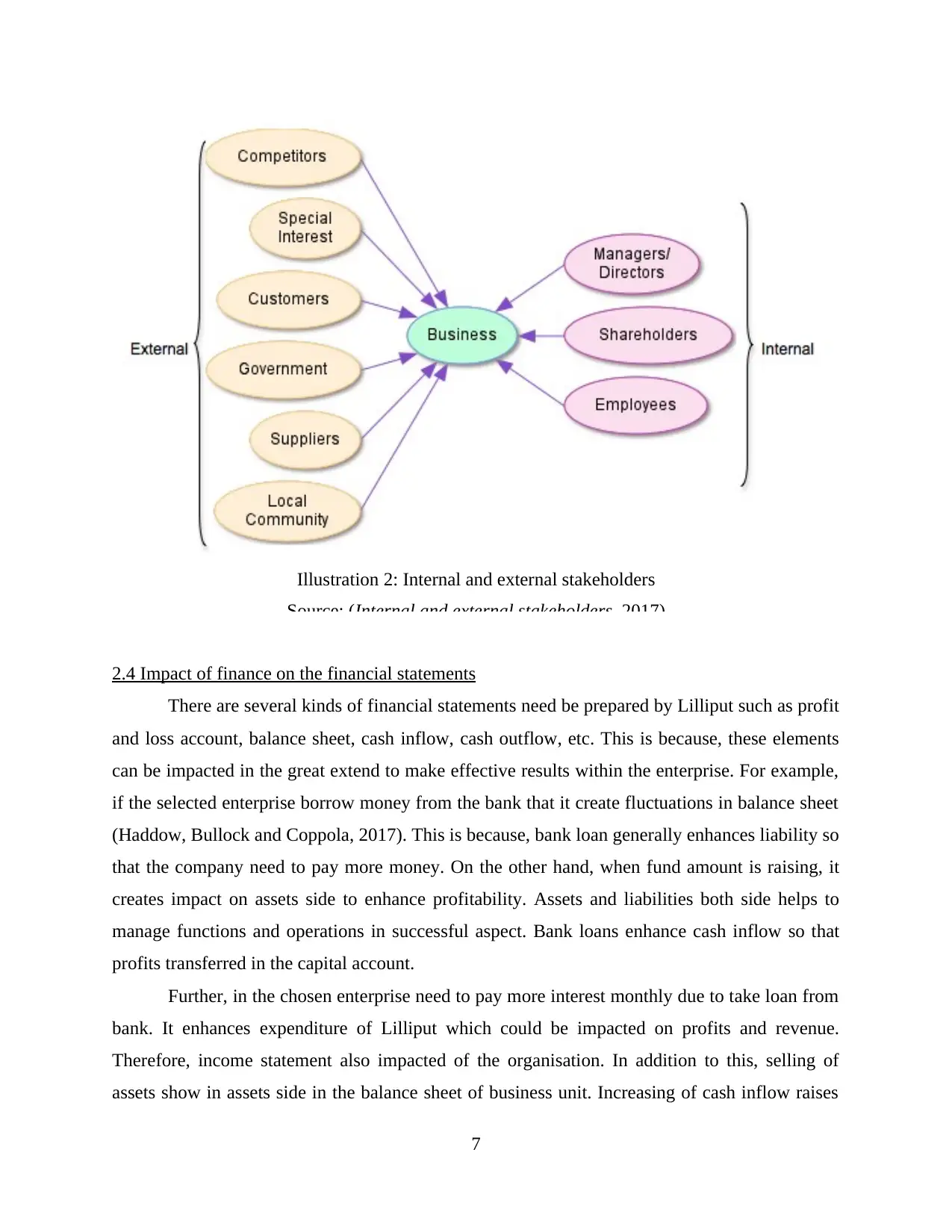
2.4 Impact of finance on the financial statements
There are several kinds of financial statements need be prepared by Lilliput such as profit
and loss account, balance sheet, cash inflow, cash outflow, etc. This is because, these elements
can be impacted in the great extend to make effective results within the enterprise. For example,
if the selected enterprise borrow money from the bank that it create fluctuations in balance sheet
(Haddow, Bullock and Coppola, 2017). This is because, bank loan generally enhances liability so
that the company need to pay more money. On the other hand, when fund amount is raising, it
creates impact on assets side to enhance profitability. Assets and liabilities both side helps to
manage functions and operations in successful aspect. Bank loans enhance cash inflow so that
profits transferred in the capital account.
Further, in the chosen enterprise need to pay more interest monthly due to take loan from
bank. It enhances expenditure of Lilliput which could be impacted on profits and revenue.
Therefore, income statement also impacted of the organisation. In addition to this, selling of
assets show in assets side in the balance sheet of business unit. Increasing of cash inflow raises
7
Illustration 2: Internal and external stakeholders
Source: (Internal and external stakeholders, 2017)
There are several kinds of financial statements need be prepared by Lilliput such as profit
and loss account, balance sheet, cash inflow, cash outflow, etc. This is because, these elements
can be impacted in the great extend to make effective results within the enterprise. For example,
if the selected enterprise borrow money from the bank that it create fluctuations in balance sheet
(Haddow, Bullock and Coppola, 2017). This is because, bank loan generally enhances liability so
that the company need to pay more money. On the other hand, when fund amount is raising, it
creates impact on assets side to enhance profitability. Assets and liabilities both side helps to
manage functions and operations in successful aspect. Bank loans enhance cash inflow so that
profits transferred in the capital account.
Further, in the chosen enterprise need to pay more interest monthly due to take loan from
bank. It enhances expenditure of Lilliput which could be impacted on profits and revenue.
Therefore, income statement also impacted of the organisation. In addition to this, selling of
assets show in assets side in the balance sheet of business unit. Increasing of cash inflow raises
7
Illustration 2: Internal and external stakeholders
Source: (Internal and external stakeholders, 2017)
Paraphrase This Document
Need a fresh take? Get an instant paraphrase of this document with our AI Paraphraser
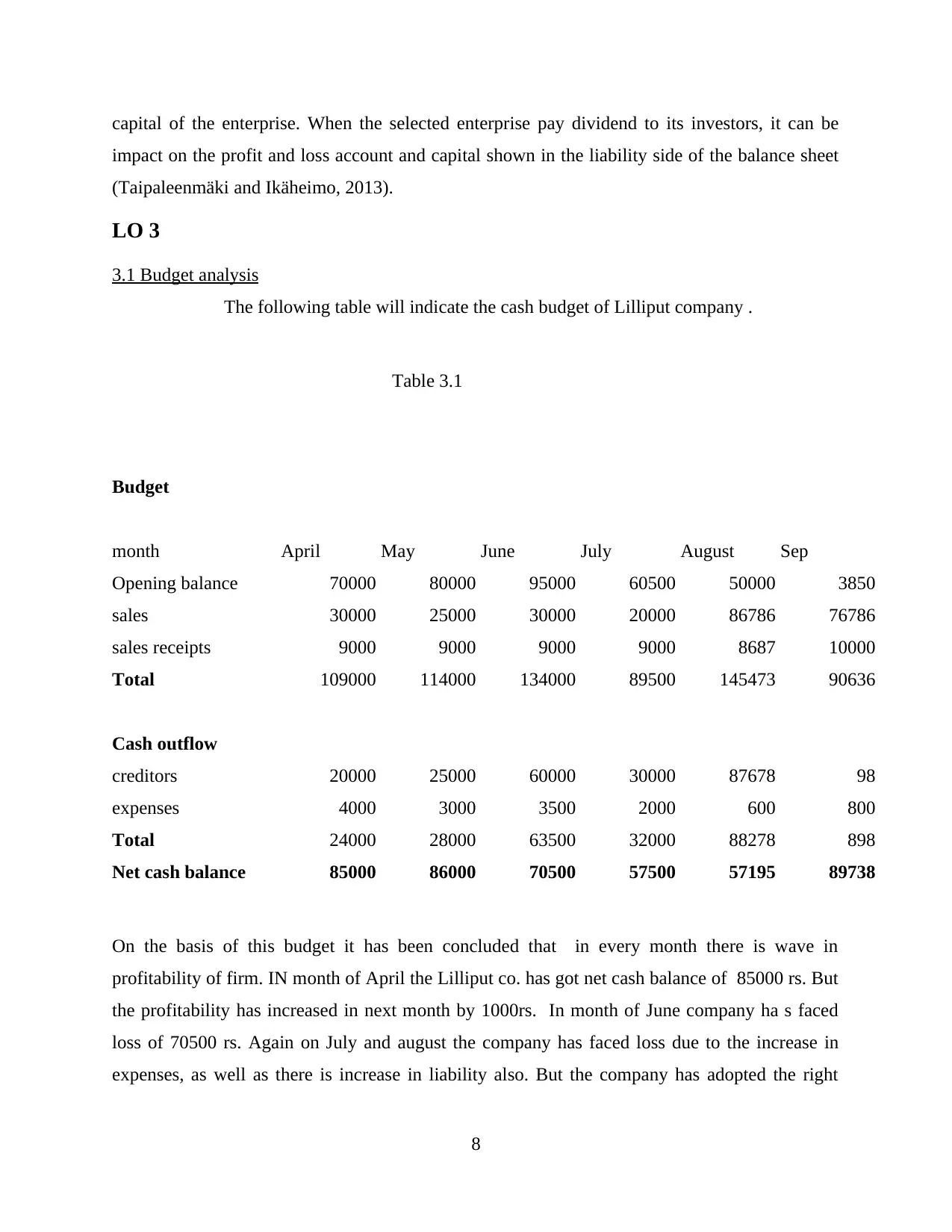
capital of the enterprise. When the selected enterprise pay dividend to its investors, it can be
impact on the profit and loss account and capital shown in the liability side of the balance sheet
(Taipaleenmäki and Ikäheimo, 2013).
LO 3
3.1 Budget analysis
The following table will indicate the cash budget of Lilliput company .
Table 3.1
Budget
month April May June July August Sep
Opening balance 70000 80000 95000 60500 50000 3850
sales 30000 25000 30000 20000 86786 76786
sales receipts 9000 9000 9000 9000 8687 10000
Total 109000 114000 134000 89500 145473 90636
Cash outflow
creditors 20000 25000 60000 30000 87678 98
expenses 4000 3000 3500 2000 600 800
Total 24000 28000 63500 32000 88278 898
Net cash balance 85000 86000 70500 57500 57195 89738
On the basis of this budget it has been concluded that in every month there is wave in
profitability of firm. IN month of April the Lilliput co. has got net cash balance of 85000 rs. But
the profitability has increased in next month by 1000rs. In month of June company ha s faced
loss of 70500 rs. Again on July and august the company has faced loss due to the increase in
expenses, as well as there is increase in liability also. But the company has adopted the right
8
impact on the profit and loss account and capital shown in the liability side of the balance sheet
(Taipaleenmäki and Ikäheimo, 2013).
LO 3
3.1 Budget analysis
The following table will indicate the cash budget of Lilliput company .
Table 3.1
Budget
month April May June July August Sep
Opening balance 70000 80000 95000 60500 50000 3850
sales 30000 25000 30000 20000 86786 76786
sales receipts 9000 9000 9000 9000 8687 10000
Total 109000 114000 134000 89500 145473 90636
Cash outflow
creditors 20000 25000 60000 30000 87678 98
expenses 4000 3000 3500 2000 600 800
Total 24000 28000 63500 32000 88278 898
Net cash balance 85000 86000 70500 57500 57195 89738
On the basis of this budget it has been concluded that in every month there is wave in
profitability of firm. IN month of April the Lilliput co. has got net cash balance of 85000 rs. But
the profitability has increased in next month by 1000rs. In month of June company ha s faced
loss of 70500 rs. Again on July and august the company has faced loss due to the increase in
expenses, as well as there is increase in liability also. But the company has adopted the right
8
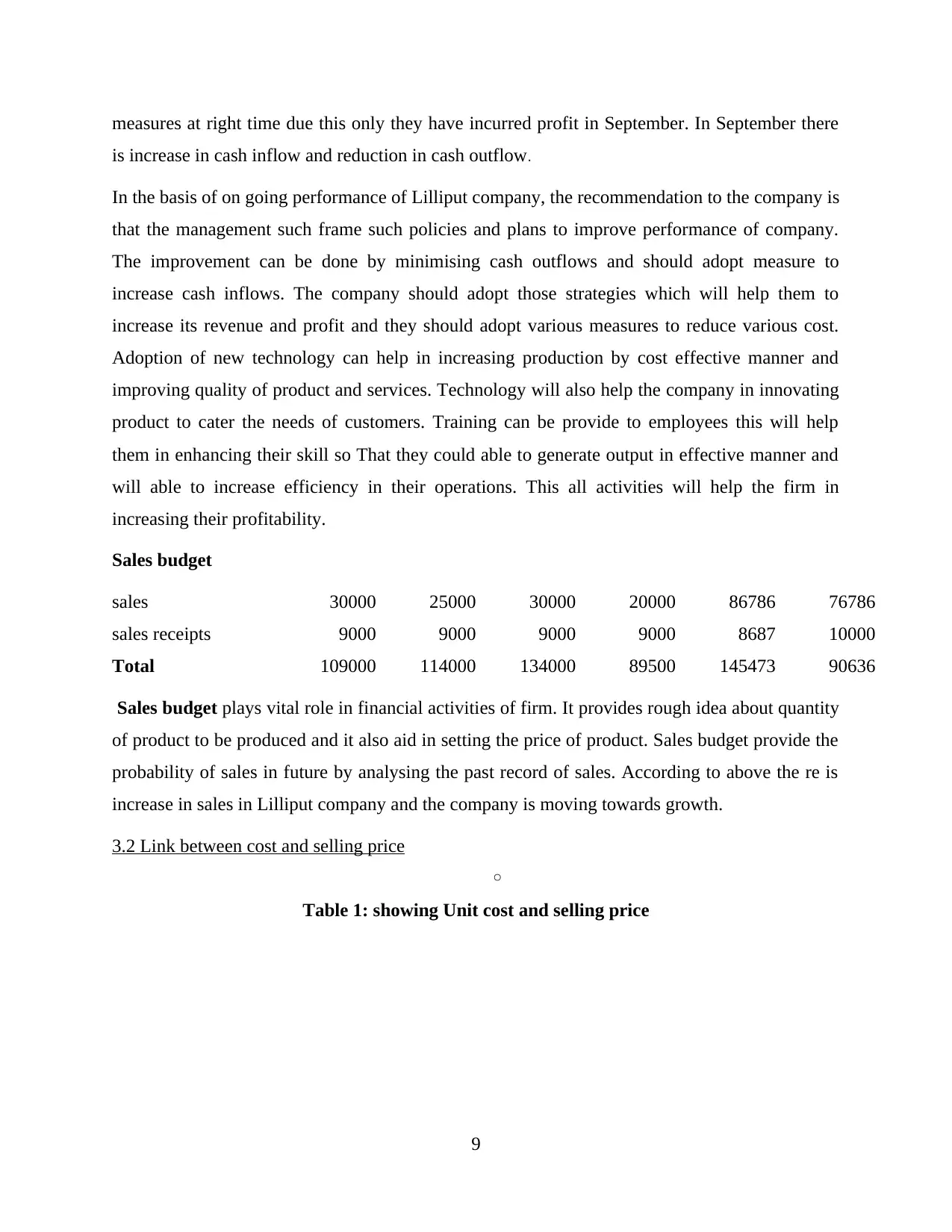
measures at right time due this only they have incurred profit in September. In September there
is increase in cash inflow and reduction in cash outflow.
In the basis of on going performance of Lilliput company, the recommendation to the company is
that the management such frame such policies and plans to improve performance of company.
The improvement can be done by minimising cash outflows and should adopt measure to
increase cash inflows. The company should adopt those strategies which will help them to
increase its revenue and profit and they should adopt various measures to reduce various cost.
Adoption of new technology can help in increasing production by cost effective manner and
improving quality of product and services. Technology will also help the company in innovating
product to cater the needs of customers. Training can be provide to employees this will help
them in enhancing their skill so That they could able to generate output in effective manner and
will able to increase efficiency in their operations. This all activities will help the firm in
increasing their profitability.
Sales budget
sales 30000 25000 30000 20000 86786 76786
sales receipts 9000 9000 9000 9000 8687 10000
Total 109000 114000 134000 89500 145473 90636
Sales budget plays vital role in financial activities of firm. It provides rough idea about quantity
of product to be produced and it also aid in setting the price of product. Sales budget provide the
probability of sales in future by analysing the past record of sales. According to above the re is
increase in sales in Lilliput company and the company is moving towards growth.
3.2 Link between cost and selling price
◦
Table 1: showing Unit cost and selling price
9
is increase in cash inflow and reduction in cash outflow.
In the basis of on going performance of Lilliput company, the recommendation to the company is
that the management such frame such policies and plans to improve performance of company.
The improvement can be done by minimising cash outflows and should adopt measure to
increase cash inflows. The company should adopt those strategies which will help them to
increase its revenue and profit and they should adopt various measures to reduce various cost.
Adoption of new technology can help in increasing production by cost effective manner and
improving quality of product and services. Technology will also help the company in innovating
product to cater the needs of customers. Training can be provide to employees this will help
them in enhancing their skill so That they could able to generate output in effective manner and
will able to increase efficiency in their operations. This all activities will help the firm in
increasing their profitability.
Sales budget
sales 30000 25000 30000 20000 86786 76786
sales receipts 9000 9000 9000 9000 8687 10000
Total 109000 114000 134000 89500 145473 90636
Sales budget plays vital role in financial activities of firm. It provides rough idea about quantity
of product to be produced and it also aid in setting the price of product. Sales budget provide the
probability of sales in future by analysing the past record of sales. According to above the re is
increase in sales in Lilliput company and the company is moving towards growth.
3.2 Link between cost and selling price
◦
Table 1: showing Unit cost and selling price
9
⊘ This is a preview!⊘
Do you want full access?
Subscribe today to unlock all pages.

Trusted by 1+ million students worldwide
1 out of 22
Related Documents
Your All-in-One AI-Powered Toolkit for Academic Success.
+13062052269
info@desklib.com
Available 24*7 on WhatsApp / Email
![[object Object]](/_next/static/media/star-bottom.7253800d.svg)
Unlock your academic potential
Copyright © 2020–2025 A2Z Services. All Rights Reserved. Developed and managed by ZUCOL.





